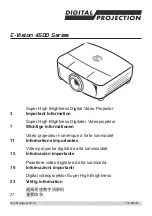
No.51666
DLA-M4000LU
DLA-M4000LE
18
Installing the Projector (Cont.)
Projection Distances and Screen Sizes
Lenses that can be used are a 3 : 1 ~ 7 : 1 zoom lens and a 1.5 : 1 fixed-focus lens. With a zoom lens used, you have a wider
latitude in selecting projection distance and installation space than with a fixed lens.
For how to install the lens, consult the dealer who installed and adjusted your projector or service center.
Relationship of screen width vs. projection distance
600
500
400
300
200
100
0
5
10
15
20
25
30
35
40
45
Screen Siz
e (T
ype)
Projection
Distance (m)
WIDE 3:1
TELE 7:1
Fixed-Focus Lens
1.5 : 1
Zoom Lens
In the shaded areas in the above graph, the projected image may be partially distorted or
missed out depending on the distance between the projector and the screen. To project an image
with no image distortion or missing, we recommend you to use the projector in the areas defined
with solid lines in the graph.
Lens
Screen Size (Type)
Projection Distance (m)
Remarks
GL-M4023SZ zoom lens
80 – 300
5.06 – 18.65
3:1 wide
(80 – 600)
(5.06 – 37.19)
60 – 200
8.65 – 28.56
7:1 tele
(60 – 300)
(8.65 – 42.79)
GL-M4015S fixed-focus lens
69 – 208
2.09 – 6.50
––––––––
(65 – 250)
(1.97 – 7.83)
Adjustable range of the lens
The numbers in ( ) represent the minimum to maximum adjustable range.
19
Connecting to Various Devices
The following signals can be input to the projector:
■
Video signals
(1) Response to color systems
*
1
: Responds if Y/C output is available.
*
2
: Signifies that component signals (“Y, P
B
, P
R
” / “ Y, B-Y, R-Y” / “G, B, R, H/C
S
, V”) conform to the signal timing (synchroniza-
tion and video period) of each color system. The color systems are used for convenience only.
*
3
: To use these terminals, a video board (separately sold) is required.
(2) Response to double density (*1), high-vision signals
Color system
NTSC 480i
NTSC4.43
PAL
SECAM
Input terminal
VIDEO*
3
‡
‡
‡
‡
Y/C*
3
‡
‡
*
1
‡
- - - - -
Y, P
B
/B-Y, P
R
/R-Y
‡
*
2
‡
*
2
‡
*
2
‡
*
2
G, B, R, H/C
S
, V
‡
*
2
‡
*
2
‡
*
2
‡
*
2
*
1
: Signals whose density of scanning lines/field is twice as high.
*
2
: Responds to signals whose horizontal scanning frequency is 31.5 kHz. NTSC can be made twice as dense by a line doubler
(separately available: recommended article). Also, possible to respond to fully-specified, decoded 525P progressive sig-
nals.
*
3
: Responds to signals whose horizontal scanning frequency is 33.5 kHz. PAL can be made twice as dense by a line doubler
(separately available: recommended article).
■
Computer signals
• Signals with the following resolutions can be input to the input terminal of RGB IN-1 (PC) or RGB IN-2 (G, B, R, H/Cs, V).
(The following signals are preset.)
Input terminal
NTSC*
2
PAL*
3
High-vision signal
Y, P
B
/B-Y, P
R
/R-Y
‡
‡
‡
G, B, R, H/C
S
, V
‡
‡
‡
Screen resolution (standard name)
Horizontal frequency
Vertical frequency
Scanning method
640
×
400 (PC-9801)
24.8kHz
56.4Hz
Non-interlace
640
×
350 (VGA1)
31.5kHz
70.1Hz
Non-interlace
640
×
480 (VGA3)
31.5kHz
59.9Hz
Non-interlace
640
×
480 (Macintosh 13”)
35.0kHz
66.7Hz
Non-interlace
640
×
480 (VGA VESA)
37.5kHz
75.0Hz
Non-interlace
800
×
600 (SVGA1)
37.9kHz
60.3Hz
Non-interlace
800
×
600 (SVGA2)
48.1kHz
72.2Hz
Non-interlace
832
×
624 (Macintosh16”)
49.7kHz
74.6Hz
Non-interlace
1024
×
768 (XGA1)
48.4kHz
60.0Hz
Non-interlace
1024
×
768 (XGA2)
56.5kHz
70.1Hz
Non-interlace
1024
×
768 (Macintosh 19”)
60.2kHz
74.9Hz
Non-interlace
1152
×
870 (Macintosh 21”)
68.7kHz
75.0Hz
Non-interlace
1280
×
1024 (SXGA1)
64.0kHz
60.0Hz
Non-interlace
1280
×
1024 (SXGA2)
70.8kHz
67.0Hz
Non-interlace
1360
×
1024 (SXGA3: Mac Board)
80.0kHz
75.1Hz
Non-interlace
Signals that Can Be Input to the Projector
* Before connection, be sure to turn off the projector and connected devices.
* Read the manual which comes with each device thoroughly.
Notes
• Interlace signals are not handled.
• Some signals other than listed above can be displayed. But they require adjustment. Even some of the signals listed above may require
adjustment depending on the video board used.
• When a signal other than listed above is input, the screen could be partially erased or an unneeded fold-over screen could appear.
• Even signals in the frequency range that can be input may not be displayed normally depending on the type of the signal.
• Composite sync.(Cs) and G on sync. signals can not handled depending on the devices connected.

































